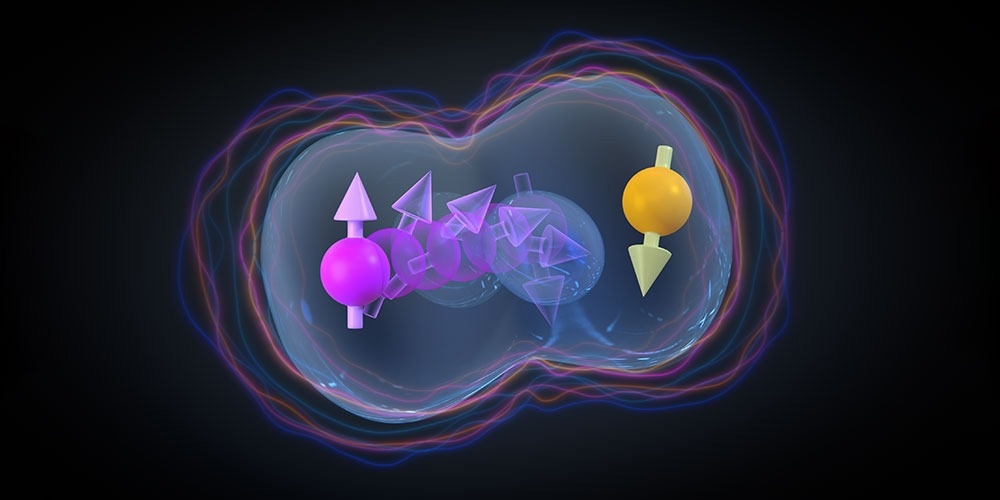Scientists from the University of Basel and the NCCR SPIN have achieved the first controllable interaction between two-hole spin qubits in a typical silicon transistor. The discovery makes it possible to use established manufacturing techniques to combine millions of these qubits on a single chip. The research was published in the journal Nature Physics.

Two interacting hole-spin qubits: As a hole (magenta/yellow) tunnels from one site to the other, its spin rotates due to spin-orbit coupling, leading to anisotropic interactions represented by the surrounding bubbles. Image Credit: NCCR SPIN
The race to build a practical quantum computer is well underway, with researchers around the world working on a huge variety of qubit technologies. Up until now, there has been no consensus on what type of qubit is most suitable for maximizing the potential of quantum information science.
A quantum computer's qubits, which manage data processing, transport, and storage, are its fundamental components. They need to process information quickly and store it accurately to function properly. Stable and quick interactions among several qubits whose states are reliably controllable externally constitute the foundation for fast information processing.
Millions of qubits need to fit on a single chip for a quantum computer to be useful. With only a few hundred qubits, the most sophisticated quantum computers available today are limited to performing tasks that can already be completed (and frequently done more quickly) by conventional computers.
Electrons and Holes
Researchers at the University of Basel and the NCCR SPIN are addressing the challenge of arranging and linking thousands of qubits by utilizing a type of qubit that exploits the spin (intrinsic angular momentum) of either an electron or a hole.
A hole is essentially a missing electron in a semiconductor. Both holes and electrons possess spin, which can adopt one of two states: up or down, analogous to 0 and 1 in classical bits. An advantage of a hole spin over an electron spin is that it can be controlled entirely through electrical means, eliminating the need for additional components such as micromagnets on the chip.
As early as 2022, physicists from Basel demonstrated that hole spins could be trapped and utilized as qubits in existing electronic devices. These devices, known as "FinFETs" (fin field-effect transistors), are integral components of modern smartphones and are manufactured through widespread industrial processes.
Recently, a team led by Dr. Andreas Kuhlmann achieved a breakthrough by successfully facilitating a controllable interaction between two qubits within this setup for the first time.
Fast and Precise Controlled Spin-Flip
Quantum computers require "quantum gates" to perform calculations; these gates are operations that manipulate qubits and link them together. As detailed in the journal Nature Physics, researchers have successfully coupled two qubits and achieved a controlled flip of one qubit's spin based on the state of the other's spin, a process referred to as a controlled spin-flip.
Hole spins allow us to create two-qubit gates that are both fast and high-fidelity. This principle now also makes it possible to couple a larger number of qubit pairs.
Dr. Andreas Kuhlmann, Department of Physics, University of Basel
The exchange interaction between two indistinguishable particles that interact electrostatically provides the basis for the coupling of two spin qubits.
Surprisingly, the exchange energy of holes is not only electrically controllable but strongly anisotropic. This is due to the spin-orbit coupling, meaning that the spin state of a hole is influenced by its motion through space.
Experimental and theoretical physicists from the NCCR SPIN and the University of Basel joined forces to describe this observation in a model.
The anisotropy makes two-qubit gates possible without the usual trade-off between speed and fidelity, Qubits based on hole spins not only leverage the tried-and-tested fabrication of silicon chips, they are also highly scalable and have proven to be fast and robust in experiments.
Dr. Andreas Kuhlmann, Department of Physics, University of Basel
The study emphasizes how promising this strategy is to create a large-scale quantum computer.
Journal Reference:
Geyer, S., et al. (2024) Anisotropic exchange interaction of two hole-spin qubits. Nature Physics. doi.org/10.1038/s41567-024-02481-5.